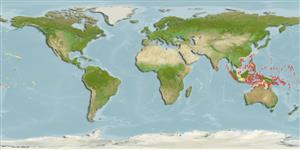>
Kurtiformes (Nurseryfishes, cardinalfishes.) >
Apogonidae (Cardinalfishes) > Apogoninae
Etymology: Taeniamia: Name from feminine Latin noun 'taenia' meaning ribbon or band; and feminine Greek noun 'Amia' meaning a fish, often used with cardinalfishes genera. Here as Taeniamia referring to the vertical wide bars and near vertical to curved narrow bars as lines on most of the species in this genus.
More on author: Lachner.
Environment: milieu / climate zone / profondeur / distribution range
Écologie
marin récifal; profondeur 0 - 33 m (Ref. 54391), usually 0 - 15 m (Ref. 54391). Tropical; 30°N - 15°S
Western Pacific: Sumatra to Tonga and Vanuatu, north to the Ryukyu Islands and south to Australia; also Palau and Mariana Islands in Micronesia.
Taille / Poids / Âge
Maturité: Lm ? range ? - ? cm
Max length : 11.0 cm TL mâle / non sexé; (Ref. 9710)
Description synthétique
Clés d'identification | Morphologie | Morphométrie
Épines dorsales (Total) : 7; Rayons mous dorsaux (Total) : 9; Épines anales: 2; Rayons mous anaux: 14 - 19. Diagnosis: Dorsal rays VII,9; anal rays 11,14-19 (usually 16-18); pectoral rays 14 (rarely 13 or 15). Lateral-line scales 25 + 3-5. Median predorsal scales 5-6 (usually 6). Gill rakers 5-7 + 15-18 (total, 20-24). Body depth 2.3-2.85 in SL, and body width 2.3-2.7 in the depth; eye diameter 2.7-3.1 in head length; first dorsal spine 2.0-2.9 in second spine; second dorsal spine 2.1-2.6, and third dorsal spine 2.2-2.7 in head length; spine of second dorsal fin 2.3-2.6, and second anal spine 2.5-2.9 in head length; pelvic-fin length 4.3-5.3, and caudal-peduncle length 4.9-5.9 in SL. Distance from insertion of pelvic spine to anal-fin origin 4.2-5.5 in SL. Posterior preopercular edge fully serrate or nearly so; serrae on upper part usually minute, rarely absent; ventral preopercular edge serrate on posterior two-thirds. Scaly sheath along anal-fin base well developed (Ref. 54391).
Body shape (shape guide): short and / or deep; Cross section: compressed.
Occurs in inshore reefs of bays or lagoons, typically hovering in small groups in the recesses of caves (Ref. 1602, 48635).
Life cycle and mating behavior
Maturité | Reproduction | Frai | Œufs | Fécondité | Larves
Mouthbrooders (Ref. 240). Distinct pairing during courtship and spawning (Ref. 205).
Gon, O. and J.E. Randall, 2003. Revision of the Indo-Pacific cardinalfish genus Archamia (Perciformes: Apogonidae), with description of a new species. Indo-Pac. Fish. (35):49 p. (Ref. 54391)
Statut dans la liste rouge de l'IUCN (Ref. 130435: Version 2025-1)
Menace pour l'homme
Harmless
Utilisations par l'homme
Outils
Articles particuliers
Télécharger en XML
Sources Internet
Estimates based on models
Preferred temperature (Réf.
123201): 26.9 - 29.3, mean 28.7 °C (based on 1370 cells).
Phylogenetic diversity index (Réf.
82804): PD
50 = 0.5001 [Uniqueness, from 0.5 = low to 2.0 = high].
Bayesian length-weight: a=0.01445 (0.00680 - 0.03071), b=3.07 (2.89 - 3.25), in cm total length, based on LWR estimates for this (Sub)family-body shape (Ref.
93245).
Niveau trophique (Réf.
69278): 3.5 ±0.5 se; based on size and trophs of closest relatives
Résilience (Réf.
120179): Haut, temps minimum de doublement de population inférieur à 15 mois (Preliminary K or Fecundity.).
Fishing Vulnerability (Ref.
59153): Low vulnerability (10 of 100).
🛈
Nutrients (Ref.
124155): Calcium = 132 [67, 216] mg/100g; Iron = 0.935 [0.540, 1.614] mg/100g; Protein = 18.7 [17.5, 19.8] %; Omega3 = 0.131 [0.075, 0.224] g/100g; Selenium = 31.4 [16.2, 60.9] μg/100g; VitaminA = 57.9 [16.9, 202.4] μg/100g; Zinc = 1.59 [1.04, 2.35] mg/100g (wet weight);
